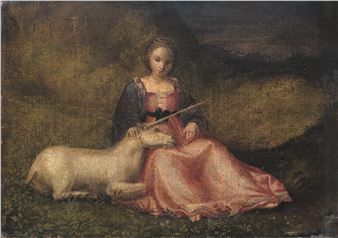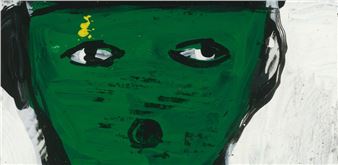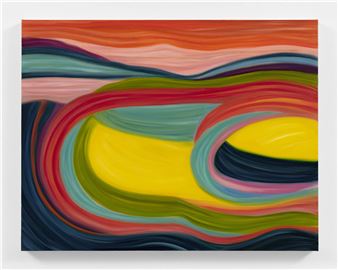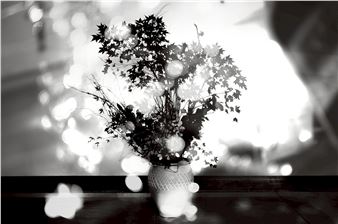Supports/Surfaces
The label Supports/Surfaces was not spirited into existence by a critic, historian or dealer. The cohesive element uniting these artists was the theoretical debate and engagement in unconventional exhibition strategies that they practiced together. Most of the artists whose names will be forever associated with Supports/Surfaces were born in the south of France, not far from the Mediterranean sea. These include Andr├ę-Pierre Arnal, Vincent Bioul├Ęs, Louis Cane, Daniel Dezeuze, Noel Dolla, Toni Grand, Bernard Pag├Ęs, Patrick Saytour and Claude Viallat. Only Marc Devade, Andr├ę Valensi and Jean-Pierre Pincemin were born in Paris.
The term ÔÇťSupport-SurfaceÔÇŁ (without the plural ÔÇťsÔÇŁ) was coined by Bioul├Ęs and first used in September 1970, for the eponymous exhibition curated by Pierre Gaudibert in the Mus├ęe d'art moderne de la Ville de Paris department called ARC (Animation Recherche Confrontation). Included were Bioul├Ęs, Devade, Dezeuze, Saytour, Valensi, Viallat and Pag├Ęs ÔÇö who retracted his participation before the opening.
The philosophical underpinnings of Supports/Surfaces drew equally from political philosophy, psychoanalysis and revolutionary socialism. They also shared a collective ambition to contest the domination of the international art scene by Americans. These strategies invested their work with conceptual rigour even as the plastic results challenged aesthetic norms. They explored unconventional materials, focussed their praxis on process, and invented new modes of exhibition in alternative spaces, out of doors, and in self-published editions. In 1971, Bioul├Ęs, Cane, Devade and Dezeuze founded the magazine called Peinture-Cahiers th├ęoriques. It closed in 1985, but remains a testimonial to the intellectual agitation of the times. It contained a heady mixture of radical political ideas and hardline modernist aesthetic. Typically, the April 1974 contained both a translation of GreenbergÔÇÖs 1961 essay ÔÇťModernist PaintingÔÇŁ, and an enthusiastic review SollersÔÇÖ book Sur le mat├ęrialisme by Louis Cane. As they matured, associates of Supports/Surfaces became the most successful artists in France. But they also became more individualistic and solitary. However, the rebellious spirit expressed under the banner of Supports/Surfaces continues to inspire their present works, which are ultimately far more subtle than the early debates which motivated them.
By now, the artists of Supports/Surfaces have, each in his own way, revealed some possible solutions to modernism running out of steam. They continue to question the notion of painting, pursuing a radically ethic aesthetic. Louis Cane used the phrase ÔÇťI donÔÇÖt see the necessityÔÇŁ as an e ective critique throughout his career. Saytour made a necessity out of his respect of recycled materials and forms, just as ViallatÔÇÖs motif is the message. For all of them, it remains essential to eschew a ectation, to work with the reality of materials, to be wary of slick fabrication. Perhaps what distinguishes them from other avant-gardes is they have been proving for decades that it is possible to produce a renaissance without saying that art is dead.

Recommended for you
The label Supports/Surfaces was not spirited into existence by a critic, historian or dealer. The cohesive element uniting these artists was the theoretical debate and engagement in unconventional exhibition strategies that they practiced together. Most of the artists whose names will be forever associated with Supports/Surfaces were born in the south of France, not far from the Mediterranean sea. These include Andr├ę-Pierre Arnal, Vincent Bioul├Ęs, Louis Cane, Daniel Dezeuze, Noel Dolla, Toni Grand, Bernard Pag├Ęs, Patrick Saytour and Claude Viallat. Only Marc Devade, Andr├ę Valensi and Jean-Pierre Pincemin were born in Paris.
The term ÔÇťSupport-SurfaceÔÇŁ (without the plural ÔÇťsÔÇŁ) was coined by Bioul├Ęs and first used in September 1970, for the eponymous exhibition curated by Pierre Gaudibert in the Mus├ęe d'art moderne de la Ville de Paris department called ARC (Animation Recherche Confrontation). Included were Bioul├Ęs, Devade, Dezeuze, Saytour, Valensi, Viallat and Pag├Ęs ÔÇö who retracted his participation before the opening.
The philosophical underpinnings of Supports/Surfaces drew equally from political philosophy, psychoanalysis and revolutionary socialism. They also shared a collective ambition to contest the domination of the international art scene by Americans. These strategies invested their work with conceptual rigour even as the plastic results challenged aesthetic norms. They explored unconventional materials, focussed their praxis on process, and invented new modes of exhibition in alternative spaces, out of doors, and in self-published editions. In 1971, Bioul├Ęs, Cane, Devade and Dezeuze founded the magazine called Peinture-Cahiers th├ęoriques. It closed in 1985, but remains a testimonial to the intellectual agitation of the times. It contained a heady mixture of radical political ideas and hardline modernist aesthetic. Typically, the April 1974 contained both a translation of GreenbergÔÇÖs 1961 essay ÔÇťModernist PaintingÔÇŁ, and an enthusiastic review SollersÔÇÖ book Sur le mat├ęrialisme by Louis Cane. As they matured, associates of Supports/Surfaces became the most successful artists in France. But they also became more individualistic and solitary. However, the rebellious spirit expressed under the banner of Supports/Surfaces continues to inspire their present works, which are ultimately far more subtle than the early debates which motivated them.
By now, the artists of Supports/Surfaces have, each in his own way, revealed some possible solutions to modernism running out of steam. They continue to question the notion of painting, pursuing a radically ethic aesthetic. Louis Cane used the phrase ÔÇťI donÔÇÖt see the necessityÔÇŁ as an e ective critique throughout his career. Saytour made a necessity out of his respect of recycled materials and forms, just as ViallatÔÇÖs motif is the message. For all of them, it remains essential to eschew a ectation, to work with the reality of materials, to be wary of slick fabrication. Perhaps what distinguishes them from other avant-gardes is they have been proving for decades that it is possible to produce a renaissance without saying that art is dead.
Contact details


 ARTISTS
ARTISTS















